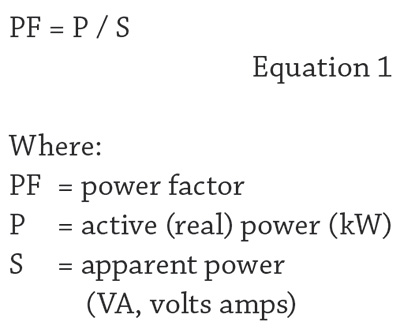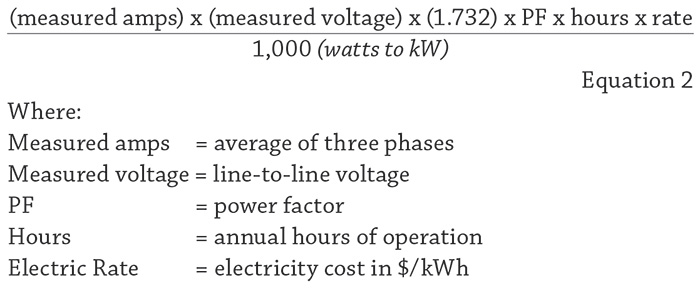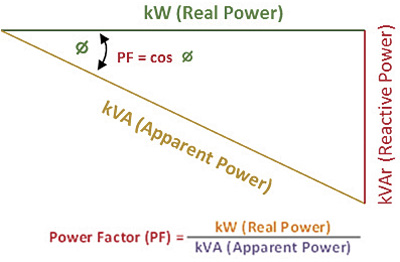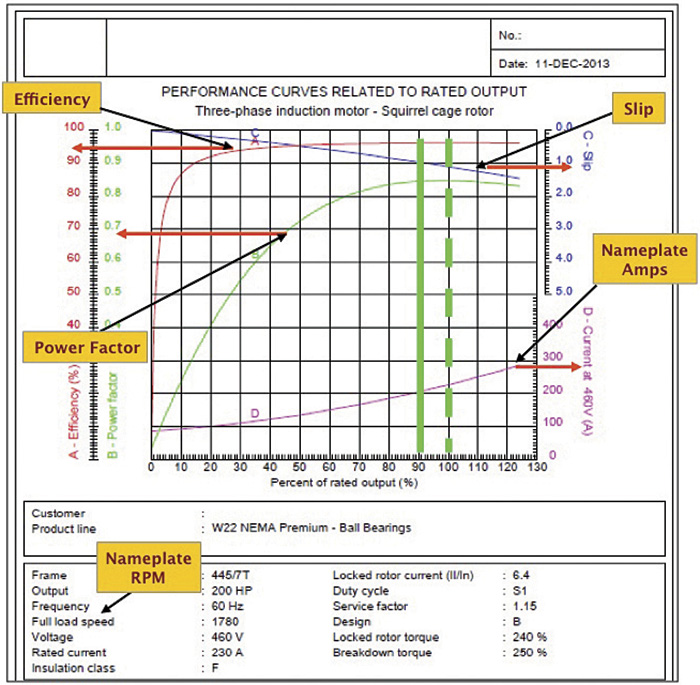What is power factor, and how does it impact your bottom line? Anyone with large induction motors in their plants or those who have been the recipients of power factor correction charges from their electric power utilities should read this article carefully.
The Institute of Electrical and Electronics Engineers and the International Electrotechnical Commission define power factor as the ratio between the applied active (real) power and the apparent power (see Equation 1).


Circuits containing purely resistive heating elements such as strip heaters and electric stoves have a power factor of 1.0 (unity power factor). Circuits containing inductive or capacitive elements such as induction motors have a power factor below 1.0. Induction motor power factor is determined primarily by the construction material. Higher permeability material results in better motor performance, lower current and a higher power factor, so the motor stator contains a majority of this material. Power factor varies from one motor manufacturer to another because of varying construction materials.

 Figure 1. The graphic shows how the power factor is derived. The kW, or real power, is what a user receives. The kVAr, or reactive power, is the extra power transmitted to compensate for a power factor less than 1.0. The combination of the two is called apparent power (kVA or volt-amperes). (Graphics courtesy of WEG Electric)
Figure 1. The graphic shows how the power factor is derived. The kW, or real power, is what a user receives. The kVAr, or reactive power, is the extra power transmitted to compensate for a power factor less than 1.0. The combination of the two is called apparent power (kVA or volt-amperes). (Graphics courtesy of WEG Electric) Besides the power factor correction charge, there is the ongoing cost for less-than-unity power factor due to the permeability of materials. Some might call it the gift that keeps on giving. Low/poor power factor continues to impact your plant bottom line (month after month) as noted in Equations 3 and 4. Failure to correct power factor to near unity can be very costly.
Users also need to be aware of motor load. Unlike motor efficiency, power factor drops off much quicker than efficiency when a motor operates at reduced load, as noted in Figure 2.
 Figure 2. At reduced load, power factor drops off much quicker than efficiency.
Figure 2. At reduced load, power factor drops off much quicker than efficiency.Notice how the power factor (green line) begins to drop off at around 80 percent load. Equation 2 shows the cost of power factor in an induction motor. It can be used to calculate annual electrical cost.
When performing the calculation, use the name plate power factor, as shown in Equation 3. The equation uses measured amperage (340) and measured voltage (460), while 1.732 is the square root of three, 0.85 is the name plate power factor, 4,160 is the operating hours, and $0.07 is the cost per kilowatt (kW). Performing the same calculation using corrected power factor 0.75 based on the motor performance data sheet, Equation 4 shows using the actual power factor. The savings can be calculated by subtracting Equation 4 from Equation 3. The savings with power factor correction (unity) equals $7,888 per year.
Advantages of correcting power factor include:
- The electrical load on the utility is reduced, allowing the utility to supply surplus power to other consumers without increasing generation capacity.
- Most utilities impose low power factor penalties, which can be substantial. By correcting the power factor, this penalty can be avoided.
- High power factor reduces the load currents, so considerable savings are made in the cost of hardware.
There are several ways to address power factor, including variable frequency drives (limited to a specific piece of equipment), static var (volt amphere reactive) compensators and dynamic var compensators (also known as synchronous condensers).
Which method to use should be evaluated based on total cost of ownership. For example, variable frequency drives are only cost-effective under certain operating conditions. Static compensators require regular maintenance and must be sized to the specific piece of equipment. Synchronous condensers can be sized to meet plant requirements, but this comes at a price.
Less-than-unity power factor can cost a company thousands of dollars. Power factor correction is a sustainable, cost-saving measure and should be considered by any company with a large installation of induction motors.


